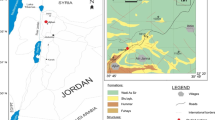Abstract
The enclosed organic matter chiefly releases lower carbon-number n-alkanes under high temperature and high pressure, while the kerogen mainly produces higher carbon-number n-alkanes. The residual hydrocarbons generated by both kerogen and enclosed organic matter in the Tieling limestone contain abundant tricyclic terpanes, pentacyclic triterpanes and steranes, but the contents of tetracyclic terpanes and 25-norhopane are lower. The residual enclosed organic matter shows the same distribution characteristics of n-alkanes, steranes and terpanes as that of the original bitumen A, i. e., the higher contents of triterpanes and tetracyclic terpanes, the higher ratios of 25-norhopanes over regular hopanes and markedly degraded steranes. By comparing the residual hydrocarbon, residual enclosed organic matter and original enclosed organic matter, it can be concluded that steranes and terpanes in the residual hydrocarbons are produced mainly by the kerogen and subordinately by the residual enclosed organic matter, the steranes and terpanes do not enter into the residual enclosed organic matter, and the thermal evolution of the residual enclosed organic matter maintains its unique character. Furthermore, pressure retards the pyrolysis of higher carbon-number alkanes and influences the isomerization ratios of C29-steranes, making 20S/(20S+ 20R) lower under the higher pressure than that under lower pressure. Higher pressure retards the thermal evolution of organic matter.
Similar content being viewed by others
References
Cheng Keming, Wang Zhaoyun, and Zhong Ningning, 1996, The theory and practice of formation of oil and gas in carbonate rocks: Beijing, Petroleum and Industry Publishing House, p. 141–153 (in Chinese).
Kenneth, E. Peters, and J. Michael Moldowan, 1993, The biomaker guide: interpreting molecular fossils in petroleum and ancient sediments: Prentice Hall, Inc., p. 170–176.
Tong Zhengyan and Bian Liangqiao, 1989, Difference of maturity of organic matter in carbonate rocks: The Proceedings of the 4th National Conference on Organic Geochemistry, p. 131–140 (in Chinese).
Zhang Shuichang and Tong Zhengyan, 1992, The composition and hydrocarbon-generation evolution of organic matter associated with carbonate minerals: Acta Sedimentologica Sinica, v. 10, n. 1, p. 76–82 (in Chinese).
Zhou Zhongyi, Fan Shanfa, and Xie Juexin, 1991, The enclosed organic matter—another profile of recognizing the mechanism of carbonate rock oil-forming: Acta Sedimentologica Sinica, v. 9(supplement), p. 112–119 (in Chinese).
Zhou Zhongyi, Ye Jixun, and Shen Guoying, 1983, Enclosed organic matter in carbonate minerals and its oilproducing significance: Geochimica, v. 3, p. 176–284 (in Chinese).
Zhou Zhongyi, Zhu Yangming, and Fan Shanfa, 1989, Effect of minerals on preservation of organic matter: The Proceedings of the 4th National Conference on Organic Geochemistry, p. 194–201 (in Chinese).
Author information
Authors and Affiliations
Rights and permissions
About this article
Cite this article
Xie, Q., Zhou, Z., Fan, S. et al. Evolution characteristics of saturated hydrocarbons of enclosed organic matter in carbonate minerals in Tieling limestone under high temperature and high pressure. Chin. J. of Geochem. 19, 85 (2000). https://doi.org/10.1007/BF03166654
DOI: https://doi.org/10.1007/BF03166654




